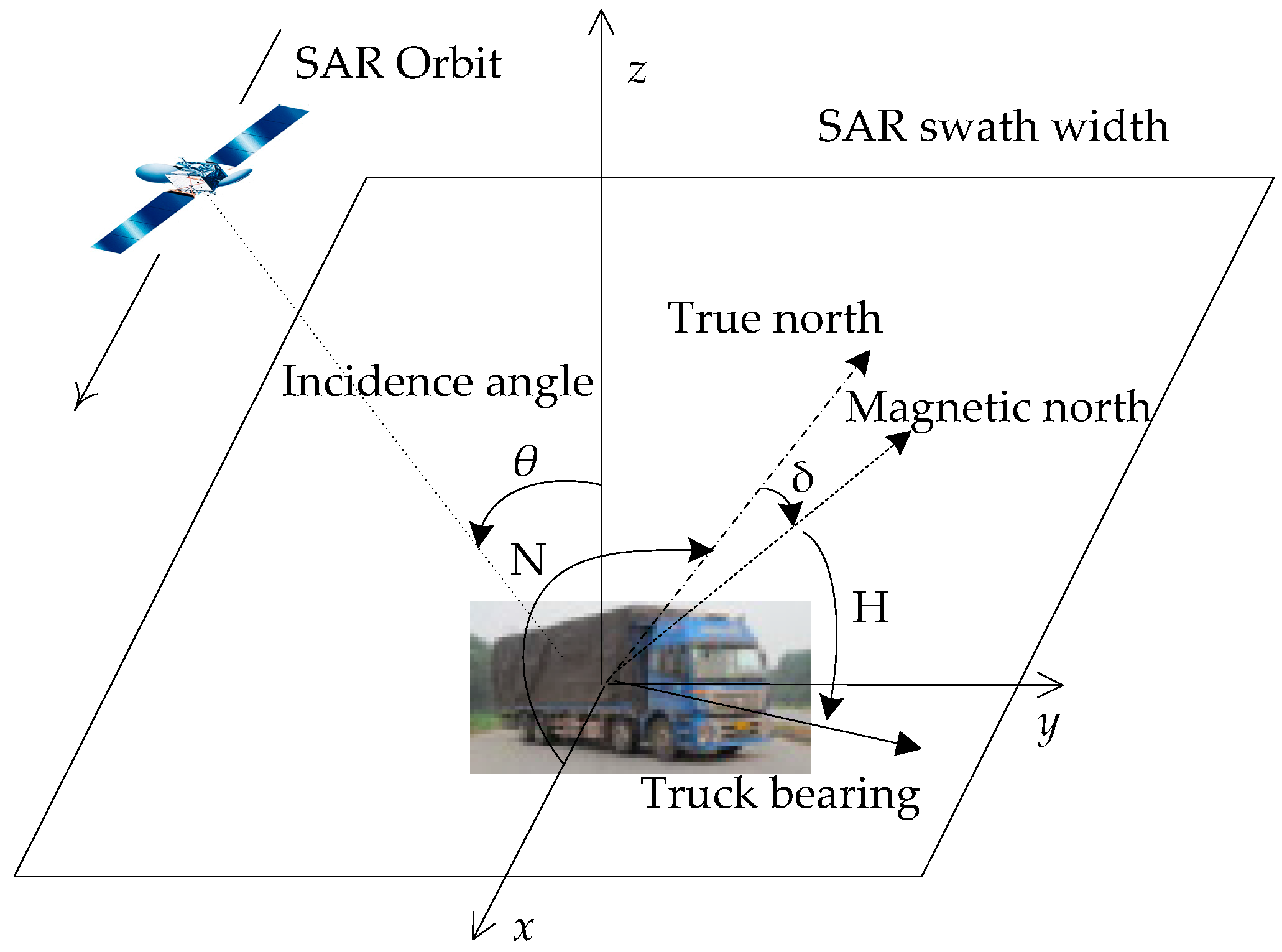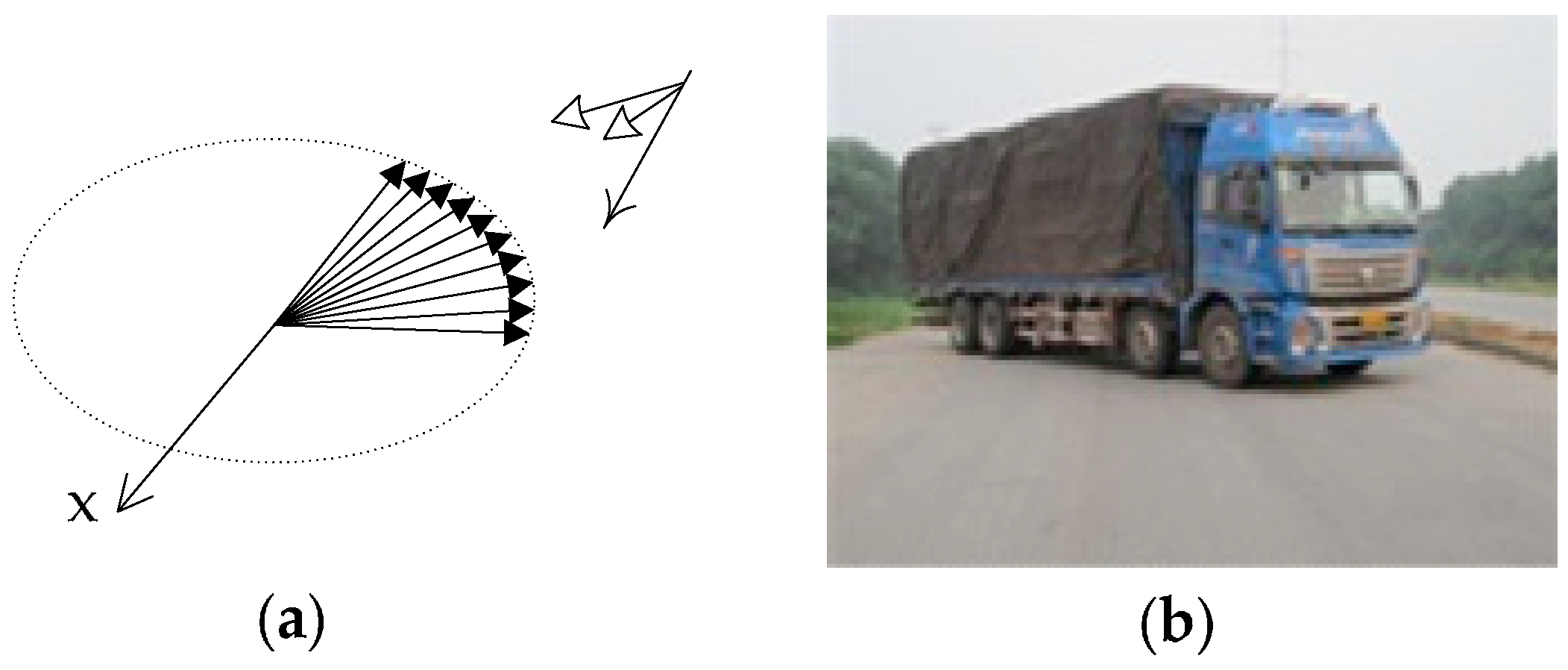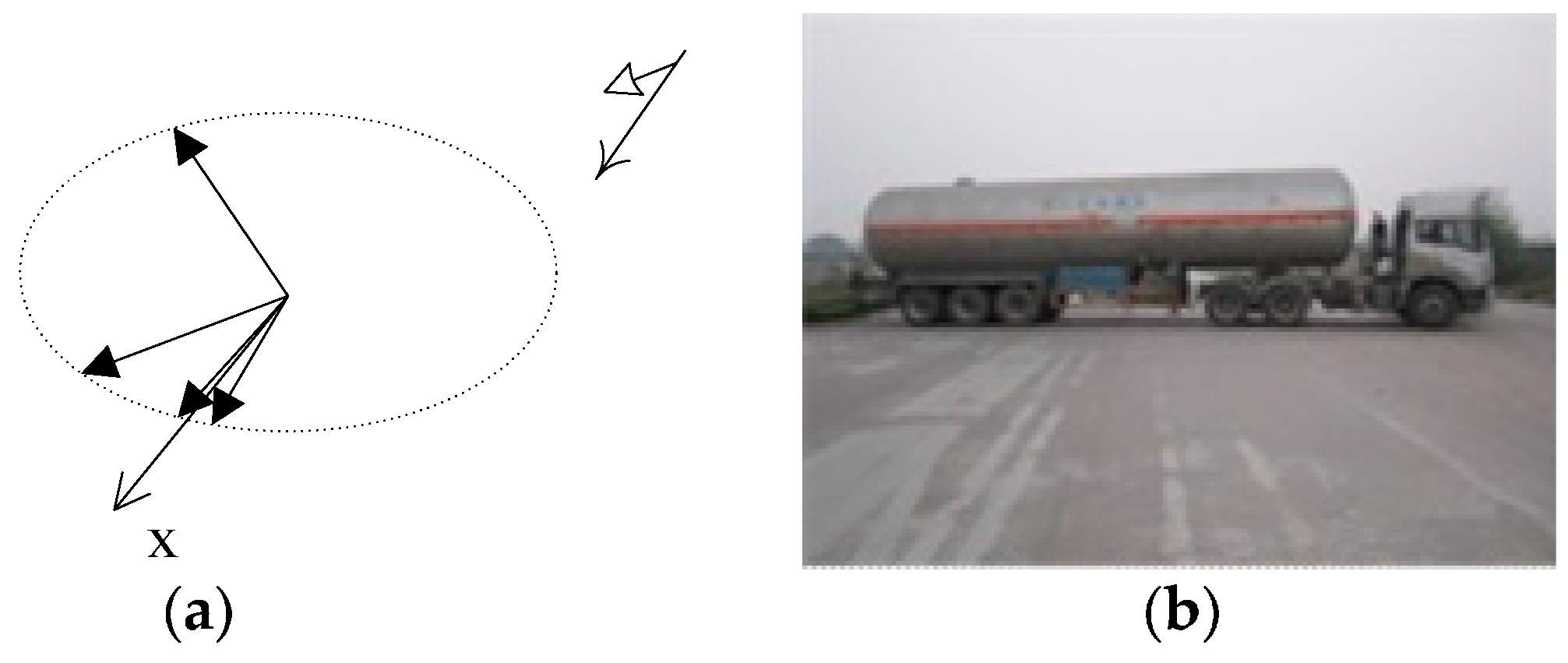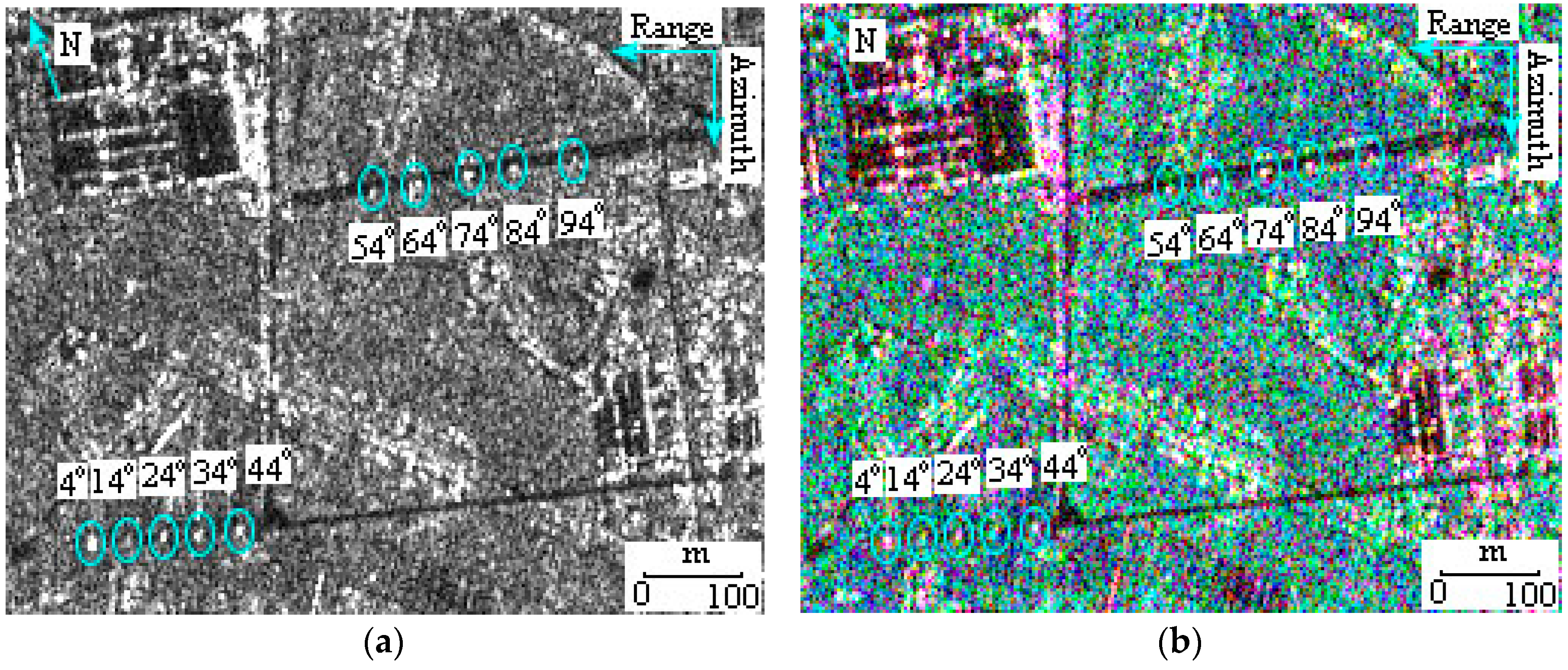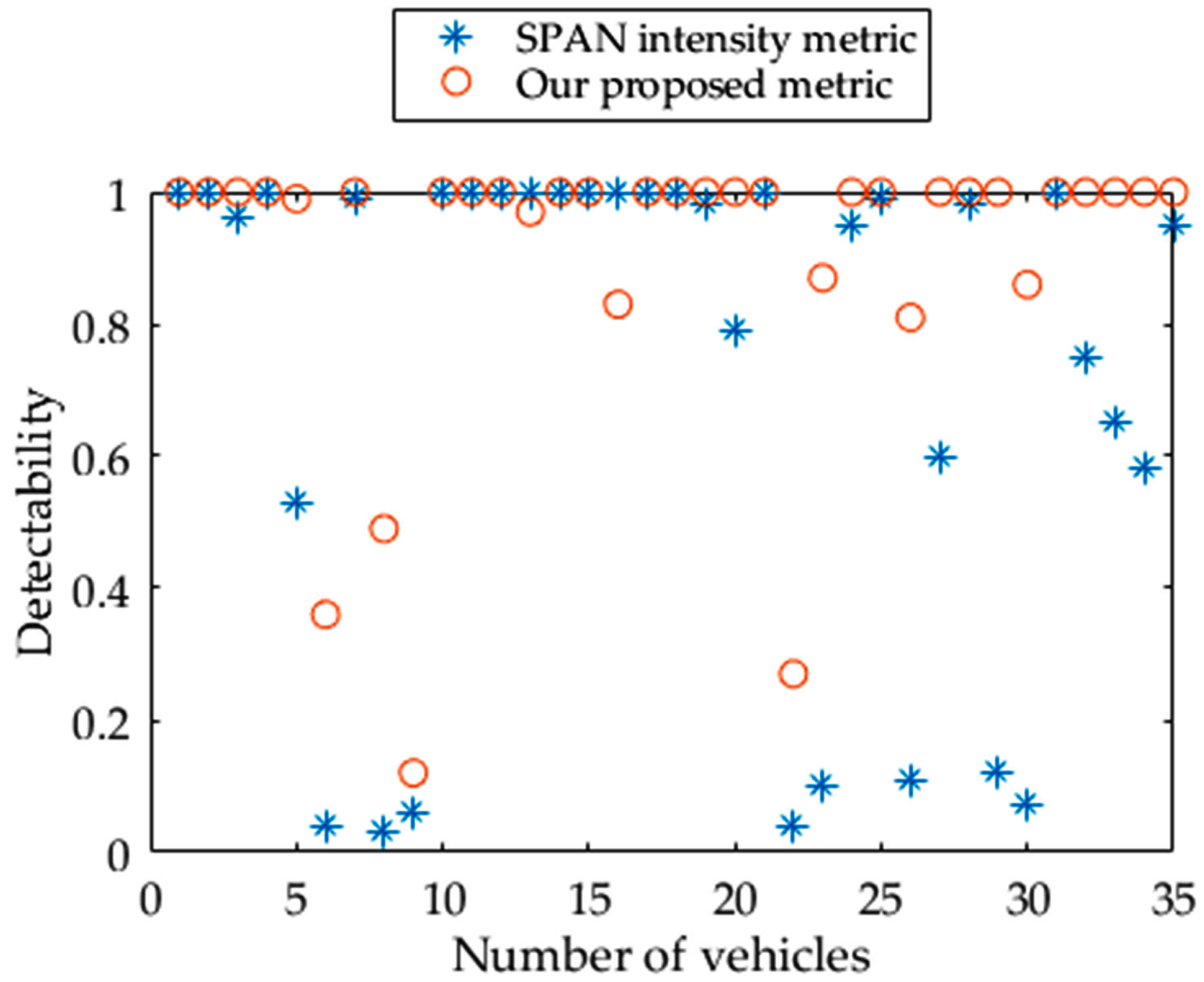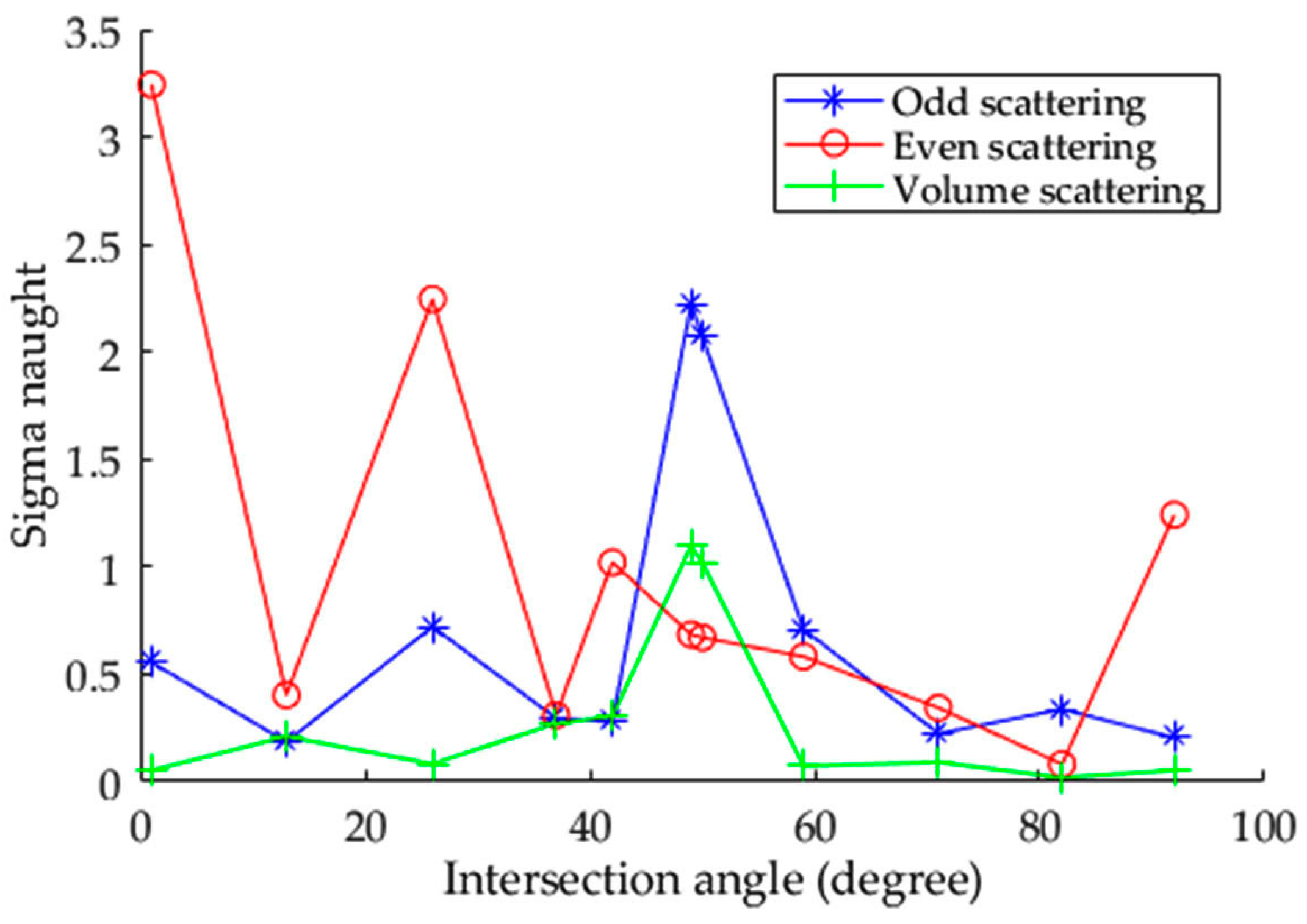1. Introduction
Compared with optic sensors, Synthetic Aperture Radar (SAR) has the advantage of being able to image under all weather conditions and is independent of solar illumination, so it is very attractive for surveillance applications. SAR images have been used extensively for marine applications, such as ship detection and classification [
1,
2]. Recently, recognition of civilian aircrafts has been demonstrated with SAR images at a 1-meter resolution [
3]. Monitoring of road vehicles in wide areas is another potential application of SAR that could be useful for transportation authorities. For example, in bad weather conditions, such as rain, snow, or fog, vehicles move slowly, and traffic becomes congested. When this occurs in a wide area, space-borne SAR may be the best choice for monitoring traffic because it can effectively capture a snapshot of the region at low cost regardless of the weather condition.
Many scholars have carried out meaningful work regarding the application of SAR images for vehicle monitoring. For example, a schedule for an operational satellite-based traffic monitoring system was designed by the German Aerospace Center (DLR) [
4]. Beginning with conceptual studies for the TerraSAR-X dual receive antenna beginning in 2003 [
5], a series of research results have been published. Their achievements can be mainly classified into four categories: quantitative analysis of the influence of target motion and velocity on displaced and blurred SAR image azimuth direction [
6,
7,
8]; analysis of parking vehicle characteristics based on SAR simulation [
8] and real air-borne experimental E-SAR (The Experimental airborne SAR System of DLR) data [
9,
10,
11]; target detector design including a Displaced Phase Centre Antenna detector, an along track interferometry (ATI) constant false alarm rate detector, an frequency modulation (FM) rate variation detector, and the integration of an a-prior knowledge detector [
8]; and experimental verification and performance analysis conducted based on air-borne E-SAR data [
9,
10,
11].
Recently, miniSAR images with a very high resolution of 0.1 m × 0.1 m were presented and used to detect cars by adapted constant false rate (CFAR) detectors [
12,
13]. Another new image mode, named wide-angle SAR, was reported and the results show that the vehicle detection performance is improved with its increased azimuth extent [
14]. Compared with the advanced air-borne miniSAR and wide-angle SAR, space-borne SAR in orbit now has limited image resolution and azimuth extent. If this space-borne SAR image is applied to vehicle detection, more issues should be considered, such as how small-sized vehicles can be confidently detected and whether fully polarimetric (FP) images can improve the probability of detection (hereinafter referred to as detectability). To address these problems, images of four common types of vehicles in China were acquired using the fully polarimetric (FP) SAR of Radarsat-2, which were then used to analyze the detectability of vehicles. Compared with the preceding literature [
10,
11,
12,
13,
14,
15], the novelties of this paper lie in the following two aspects. First, more factors that affect the detectability of vehicles in space-borne SAR images are taken into account, for e.g., the vehicle’s size, shape and aspect angles. As a result, the importance of these factors is quantitatively analyzed and compared according to their effect on detectability. Moreover, to demonstrate the potential application of traffic monitoring with fine resolution of FP SAR images, a new metric to improve detectability is proposed. This metric is based on the technique of polarimetric decomposition and its performance is validated by comparison with the traditional intensity metric.
The remainder of this paper is organized as follows:
Section 2 introduces experimental Radarsat-2 FP SAR images and features of four types of road vehicles.
Section 3 describes the calculation methods for the detectability of road vehicles. Experiments and discussion of the influence on vehicle detectability are presented in
Section 4 and
Section 5, respectively. Finally, in
Section 6, conclusions are drawn regarding the potential application of these results for traffic monitoring.
5. Results and Discussion
Under the support of a geometric model of man-made objects, it is convenient to understand SAR images for backscattering analysis [
20,
21]. Taking into account the symmetry of the geometric models of the vehicles, the backscatter intensity is the same from both the left and right sides. For this reason, the scope of the aspect angle in this paper can be reduced from 360° to 180°. In the following discussion, the aspect angle is replaced by the minimum intersection angle in the range of [0°, 180°], which is the angle between the
x-axis and the long side of the vehicle.
Figure 5, as an example, is the FP image acquired in experiment III, in which ten larger trucks circled by cyan ellipses are parking at consecutive intersection angles. To quantitatively analyze the detectability under various influences, the vehicle intensities in SPAN and Pauli decomposed images are calculated using the aforementioned methods and applied to the following discussion.
5.1. Analysis of the Influence of the Vehicle’s Size on Detectability
Three types of vehicles of different sizes were parked at the same intersection angles and imaged by SAR using the same imaging parameters in Experiment I.
Figure 6 presents the maximum
of each vehicle at each intersection angle and the mean value of road background in the SPAN image.
Table 3 shows the value
of each vehicle calculated using Formula (6), where the
is first calculated using Formula (7) with the
set as the intensity value of the medium truck at the intersection angle of 45°.
According to
Table 3, a larger vehicle has a higher detectability than a smaller vehicle. This conclusion is based on the fact that the intensity results in this experiment are most likely only caused by the different vehicle sizes, since the other imaging parameters, such as shape, incidence angle, and intersection angle, are the same. In addition, all vehicles have a maximum intensity value at the intersection angle of 0°, where their long side is facing the illumination direction of the SAR. As the intersection angle increases, vehicle intensity in the SPAN image decreases due to the lessening of the areas projected on the perpendicular plane of the SAR illumination. The medium truck and bus have low detectability at the intersection of 90° because of their small head size and smooth top roof. Thus, it may also be concluded that it is difficult to obtain a higher value of
at all intersection angles when the size of the parallelepiped-shaped vehicle is smaller than the SAR image resolution.
5.2. Analysis of the Influence of Intersection Angle on Detectability
In Experiments II and III, the
measurement of each vehicle at the corresponding intersection angle is marked in
Figure 7. Investigating the changes of RCS over all of the intersection angles is an effective means to understand the mechanism of backscattering oscillation. This method is employed to interpret the backscattering fluctuation of buildings with varied orientation [
22]. To clearly show the overall tendency of
with intersection angles, an envelope line covering all of the
values for each vehicle is drawn in
Figure 7.
The main feature of
Figure 7 is that the intensity of the vehicles oscillates with an increasing intersection angle. Following the envelope of
, however, we can see that there are two peaks located near the intersection angles of 0° and 45°. This is due to the dihedral mechanism of SAR, which is formed between the vehicle side and the road near the intersection angle of 0°, and a natural trihedral mechanism of SAR is caused by the truck’s rear tail at approximately the intersection angle of 45°. Unfortunately, some trucks at approximately 45° do not have a high
value while they are loading because the trihedral corner at the rear tail facing the SAR is filled.
5.3. Analysis of the Influence of a Vehicle’s Shape on Detectability
SAR images of tank trucks and larger trucks were acquired with similar incidence angles in Experiments III and IV, respectively. To compare their intensities at close aspect angles, the aspect angles of four tank trucks are reduced to 2°, 45°, 29°, and 9° in
Figure 8 based on an assumption that the target with intersection angles D° and
has equal backscattering intensity. The reason underlying this assumption is that the intensity at the intersection angle
D° is caused by SAR illuminating from head to tail, which is similar to that resulting from illuminating in the opposite direction, i.e., an intersection angle
.
The tank truck near intersection angle 0° has a higher intensity than those at the other three intersection angles. This phenomenon in
Figure 8 is consistent with that in
Figure 6 and
Figure 7 for the other types of vehicles. Because the cylindrical-shaped tank trucks are bigger than the larger trucks, it is reasonable to expect that tank trucks may cause higher backscatter intensity. However, the intensity of the tank trucks is actually lower than that of the larger trucks at almost all intersection angles. This is mainly due to the crucial factor of shape, because the other parameters, such as incidence angle and aspect angle, are all similar. In detail, the smooth shape of the cylindrical tank has few areas to produce specular, double-bounce, and multiple reflections back to the SAR sensor. For the parallelepiped-shaped larger truck, however, the rough top roof creates diffuse backscattering during loading and forms a trihedral mechanism in the SAR when idling. In addition, the parallelepiped-shaped body on the road background forms a dihedral structure and constitutes more opportunities for backscatter to the SAR. Thus, it may be concluded that shape is a more crucial factor than size for producing higher detectability in SAR images.
5.4. Detectability Comparison between Different Metrics
CFAR detector is a well-known tool to detect objects in SAR images based on intensity metric, which has been widely applied to applications such as vessel and vehicle detection [
12,
18].
Figure 9 shows the detectability of all the vehicles in our experiments by using Formula (6), in which the same
is employed. These values are calculated based on the SPAN intensity metric and our proposed metric (M), respectively.
Notably, the low detectability calculated by the SPAN intensity metric is significantly improved with the new metric, , especially for vehicles with a small size. In detail, there are eight vehicles below the detectability of 0.5 using the SPAN intensity metric. In contrast, the number of vehicles with detectability less than 0.5 is reduced to four using the new metric. Meanwhile, overall detectability is improved from 0.72 to 0.90 when the new metric is applied. In short, in comparison with the traditional SPAN intensity metric, the new metric is effective for improving vehicle detectability based on the polarimetric decomposition technique.
The reasons for the excellent performance achieved by this new metric can be analyzed as follows. For the process of Pauli decomposition, the boxcar filter is applied as a standing process to suppress the speckle intensity in single-look FP SAR images. Therefore, a small
value as the denominator in
is generated in the road background region, which is homogeneous and fits a normal distribution with stable statistic parameters [
18]. In contrast, it is not feasible to predict which Pauli component is high around the vehicle region due to the vehicle’s heterogeneous characteristics. For the proposed metric to achieve a high value of
, the highest value among the three Pauli components at pixel position
is selected in Formula (8), and then the vehicle detectability is improved as the value of the numerator of
is increased.
Several similar metrics were also proposed for ship detection [
23,
24,
25]. However, they are based on the same reasonable assumption that the ship is dominated by even-bounce scattering and line bounce scattering in fully polarimetric (FP) SAR images, while the sea is dominated by odd-bounce scattering [
23,
24]. Thus, those metrics select some certain decomposed polarimetric parameters to achieve excellent performance [
25]. However, intensity oscillating with the change of aspect angle is the main characteristic of vehicle backscattering. Specifically, none of the decomposed Pauli components are dominant through the aspect angle range, as shown in
Figure 10. Based on this fact, our new metric (M) is designed to automatically select the highest Pauli decomposed component value of a vehicle and, therefore, gets better performance of detectability.
6. Conclusions
To extend the application of SAR images for vehicle detection and monitoring of traffic congestion, in our experiments, images of four common types of vehicles in China with different sizes, shapes, and aspect angles were acquired with FP Radarsat-2. Then, vehicle characteristics were measured and analyzed. Their detectability was calculated and compared between two methods that were based on the SPAN intensity and decomposed polarimetric components.
Although the RCS is a function of combined parameters related to SAR imaging and vehicle, general conclusions based on the quantitative analysis of our experimental results can be drawn as follows. The significant characteristic of the RCS from the same type of vehicle is that it oscillates with the change of aspect angle. For different types of vehicles, however, the shape factor has more influence on the detectability than the size factor. In detail, from the viewpoint of the aspect angle factor, a vehicle has a high probability of detection when it is heading parallel to the direction of the SAR orbit. From the standpoint of the size factor, a small vehicle is difficult to detect if its size is smaller than that of the SAR image resolution. From the shape perspective, a vehicle that contains more canonical structures, such as dihedral and trihedral structures, has higher detectability than one with a smooth surface. In addition, detectability can be significantly improved using polarimetric decomposition for FP SAR images, whose performance is evaluated and validated by comparison between our proposed method and the traditional SPAN intensity method.
In addition, the vehicles used in our experiments are all electrically large objects in comparison to the wavelength of Radarsat-2. Since the Radarsat-2 wavelength at the C-band is longer than that of COSMO-SkyMed (COnstellation of small Satellites for the Mediterranean basin Observation) and TerraSAR-X at the X-band, it reasonable that our research results may be beneficial in the application of vehicle detection using COSMO-SkyMed and TerraSAR-X images.
